Zebu
The zebu (/ˈziːb(j)uː, ˈzeɪbuː/; Bos indicus or Bos taurus indicus), sometimes known in the plural as indicine cattle, Camel cow or humped cattle, is a species or subspecies of domestic cattle originating in South Asia.[4] Zebu, like many Sanga cattle breeds, differs from taurine cattle by a fatty hump on their shoulders, a large dewlap, and sometimes drooping ears. They are well adapted to withstanding high temperatures and are farmed throughout the Tropics.
| Zebu | |
|---|---|
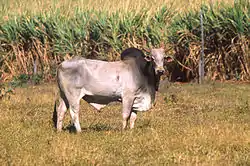 | |
| Scientific classification (Disputed,[1] see § Taxonomy and name) | |
| Domain: | Eukaryota |
| Kingdom: | Animalia |
| Phylum: | Chordata |
| Class: | Mammalia |
| Order: | Artiodactyla |
| Family: | Bovidae |
| Subfamily: | Bovinae |
| Genus: | Bos |
| Species: | |
| Subspecies: | B. t. indicus |
| Trinomial name | |
| Bos taurus indicus | |
| Synonyms[2][3] | |
| |
Zebu are used as draught and riding animals, dairy cattle and beef cattle, as well as for byproducts such as hides and dung for fuel and manure. Some small breeds such as the miniature zebu are also kept as pets.
In some regions, such as parts of India, zebu and other cattle have significant religious meaning.
Taxonomy and name
Both scientific names Bos taurus and Bos indicus were introduced by Carl Linnaeus in 1758, with the latter used to describe humped cattle in China.[3]
The zebu was classified as a distinct species by Juliet Clutton-Brock in 1999,[5] but as a subspecies of the domestic cattle, Bos taurus indicus, by both Clutton-Brock and Colin Groves in 2004 and by Peter Grubb in 2005.[6][7] In 2011, Groves and Grubb classified it as a distinct species again.[8]
The American Society of Mammalogists considers it part of the species Bos taurus in analogy to Sanga cattle (Bos taurus africanus Kerr, 1792).[2] The ICZN has not yet published a ruling on the classification of domestic derivatives and no scientific body advocates the abolition of the Biological Species Concept for domestic animals.
Origin
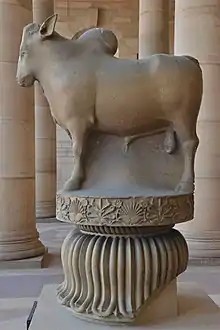
.jpg.webp)
Zebu cattle were found to derive from the Indian form of aurochs and have first been domesticated between 7,000 and 6,000 YBP at Mehrgarh, present-day Pakistan, by people linked to or coming from Mesopotamia.[9][10][11][12] Indicine cattle farming is understood to have spread across much of South Asia by 2000 BCE.
Its wild ancestor, the Indian aurochs, became extinct during the Indus Valley civilisation likely due to habitat loss, caused by expanding pastoralism and interbreeding with domestic zebu.[4][13] Its latest remains ever found were dated to 3,800 YBP, making it the first of the three aurochs subspecies to die out.[14][15][16]
Archaeological evidence including depictions on pottery and rocks suggests that humped cattle likely imported from the Near East was present in Egypt around 4,000 YBP. Its first appearance in the Subsahara is dated to after 700 AD and it was introduced to the Horn of Africa around 1000.[17]
Phylogenetic analysis revealed that all the zebu Y chromosome haplotype groups are found in three different lineages: Y3A, the most predominant and cosmopolitan lineage; Y3B, only observed in West Africa; and Y3C, predominant in south and northeast India.[18]
Characteristics
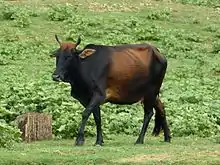
Zebu, but also many Sanga cattle have humps on the shoulders, large dewlaps and droopy ears.[19] Sanga cattle can be distinguished from purebred zebu by their having smaller humps located farther forward.
Compared to taurine cattle, zebus are well adapted to the hot savanna and steppe environments. These adaptations result in higher tolerance for drought, heat and sunlight exposure.[20] Unlike many Sanga cattle however, zebu does not exhibit trypanotolerance, making it susceptible to nagana,[21][22] as evidenced by the pattern of zebu introgression into African cattle.[21]
Furthermore, another important characteristic of the Zebu is that they are able to defend against parasites and diseases quite well.[23]
Reproduction
Zebu are generally mature enough to give birth when they are 29 months old. This is based on the development of their bodies to withstand the strain of carrying and lactation. Early reproduction can place too much stress on the body and possibly shorten lifespans. Carrying time of the calf averages at 285 days, but varies depending on the age and nutrition of the mother. The sex of the calf may also affect the carrying time, as male calves are carried for a longer period than females. Location, breed, body weight, and season affect the overall health of the animal and in return may also affect the carrying period.[20]
Behavior
Studies on the natural weaning of zebu cattle have shown that the cow weans her calves over a 2-week period, but after that, she continues to show strong affiliatory behavior with her offspring and preferentially chooses them for grooming and as grazing partners for at least 4–5 years.[24]
Breeds and hybrids
Zebu are very common in much of Asia, including Pakistan, India, Nepal, Bangladesh and China. In Asia, taurine cattle are mainly found in the northern regions such as Japan, Korea, northern China and Mongolia. In China, taurine cattle are most common in northern breeds, zebu more common in southern breeds, with hybrids in between.[25][26]
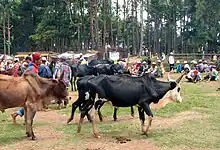
Zebu were imported to Africa since the Bronze Age and crossed with taurine cattle. Genetic analysis of African cattle found higher proportions of zebu genes along the East African coast, with hardly any taurine component on Madagascar, either implying that the method of dispersal was cattle transported by ship or the zebu may have reached East Africa via the coastal route (via Pakistan, Iran, Yemen).
Partial resistance to rinderpest caused a further increase of zebu breeds in Africa.
Geneticists at the International Livestock Research Institute (ILRI) in Nairobi, Kenya and in Addis Ababa, Ethiopia discovered that cattle had been domesticated in Africa independently of domestication in the Near East. They concluded that the southern African cattle populations derive originally from East Africa rather than from a southbound migration of taurine cattle.[27] The results are inconclusive as to whether domestication occurred first in Africa or the Near East.[28]
Other scientists consider the African Sanga cattle breeds to have originated from hybridization of zebu with indigenous African humpless cattle leading to the Afrikaner, Red Fulani, Ankole, Boran and many other breeds.
Some 75 breeds of zebu are known, split about evenly between African and Indian breeds.
| List of widely distributed zebu breeds |
|
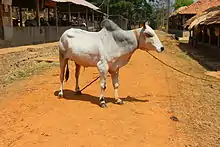
Other breeds of zebu are quite local, like the Hariana from Haryana, Punjab[30] or the Rath from Alwar district, Rajasthan.[31]
Zebu, which are adapted to high temperatures,[32] were imported into Brazil in the early 20th century. Their importation marked a change in cattle ranching in Brazil as they were considered "ecological" since they could graze on natural grasses and their meat was lean and without chemical residues.[33]
In the early 20th century in Brazil, Zebu were crossbred with Charolais cattle, a European taurine breed. The resulting breed, 63% Charolais and 37% zebu, is called the Canchim. It has a better meat quality than the zebu and better heat resistance than European cattle. The zebu breeds used were primarily Indo-Brazilian with some Nelore and Guzerat. Another Charolais cross-breed with Brahmans is called Australian Charbray and is recognised as a breed in some countries.
From the 1960s onwards, Nelore which is an off breed of Ongole Cattle became the primary breed of cattle in Brazil because of its hardiness, heat-resistance, and because it thrives on poor-quality forage and breeds easily, with the calves rarely requiring human intervention to survive. Currently more than 80% of beef cattle in Brazil (approximately 167,000,000 animals) are either purebred or hybrid Ongole Cattle which is originated from Ongle region of Andhra Pradesh.
Uses

Zebu are used as draught and riding animals, beef cattle, dairy cattle, as well as for byproducts such as hides, dung for fuel and manure, and horn for knife handles and the like. Zebu, mostly miniature zebu, are kept as pets.[34] In India, the number of draft cattle in 1998 was estimated at 65.7 million head.[35]
Zebu cows commonly have low production of milk. They do not produce milk until maturation later in their lives and do not produce much. When zebus are crossed with taurine cattle, milk production generally increases.[20]
In 1999, researchers at Texas A&M University successfully cloned a zebu.[36]
Jallikattu in India is a bull taming sport differing from European bullfighting in that humans are unarmed and the bulls are not killed.
Hindu tradition
Zebu are venerated within the Hindu religion of India. In the Vedic period they were a symbol of plenty.[37]: 130 In later times they gradually acquired their present status. According to the Mahabharata, they are to be treated with the same respect 'as one's mother'.[38] In the middle of the first millennium, the consumption of beef began to be disfavoured by lawgivers.[37]: 144 Cows appear in numerous stories from the Vedas and Puranas. The deity Krishna was brought up in a family of cowherders, and given the name Govinda (protector of the cows). Also, Shiva is traditionally said to ride on the back of a bull named Nandi.
Milk and milk products were used in Vedic rituals.[37]: 130 In the postvedic period products of the cow—milk, curd, ghee, but also cow dung and urine (gomutra), or the combination of these five (panchagavya)—began to assume an increasingly important role in ritual purification and expiation.[37]: 130–131
References
- International Commission on Zoological Nomenclature (1922). "Opinion 75. Twenty-Seven Generic Names of Protozoa, Vermes, Pisces, Reptilia and Mammalia Included in the Official List of Zoological Names". Smithsonian Miscellaneous Collections. 73 (1): 35–37.
- American Society of Mammalogists (2021). "Bos taurus". ASM Mammal Diversity Database. Archived from the original on May 1, 2023.
[Bos taurus] includes indicus, which is often treated as a distinct species; because both domestic forms originate from a single wild species [Bos primigenius], they are considered a single taxon here
, citing:- Gentry, Anthea; Clutton-Brock, Juliet; Groves, Colin P (2004-05-01). "The naming of wild animal species and their domestic derivatives". Journal of Archaeological Science. 31 (5): 645–651. Bibcode:2004JArSc..31..645G. doi:10.1016/j.jas.2003.10.006. and
- Groves, Colin P.; Grubb, Peter (2011). Ungulate taxonomy. Baltimore (Md.): J. Hopkins university press. ISBN 978-1-4214-0093-8.
- Linnaeus, C. (1758). "Bos indicus". Systema naturae per regna tria naturae: secundum classes, ordines, genera, species, cum characteribus, differentiis, synonymis, locis (in Latin). Vol. 1 (Tenth reformed ed.). Holmiae: Laurentii Salvii. p. 71.
- Chen, Shanyuan; Lin, Bang-Zhong; Baig, Mumtaz; Mitra, Bikash; Lopes, Ricardo J.; Santos, António M.; Magee, David A.; Azevedo, Marisa; Tarroso, Pedro; Sasazaki, Shinji; Ostrowski, Stephane (2010-01-01). "Zebu Cattle Are an Exclusive Legacy of the South Asia Neolithic". Molecular Biology and Evolution. 27 (1): 1–6. doi:10.1093/molbev/msp213. ISSN 0737-4038. PMID 19770222.
- Clutton-Brock, J. (1999) [1987]. "Asiatic cattle". A Natural History of Domesticated Mammals (Second ed.). Cambridge, UK: Cambridge University Press. p. 85. ISBN 978-0-521-63495-3. OCLC 39786571.
- Gentry, A.; Clutton-Brock, J. & Groves, C.P. (2004). "The naming of wild animal species and their domestic derivatives". Journal of Archaeological Science. 31 (5): 645–651. Bibcode:2004JArSc..31..645G. doi:10.1016/j.jas.2003.10.006.
- Grubb, P. (2005). "Subspecies Bos taurus indicus". In Wilson, D.E.; Reeder, D.M (eds.). Mammal Species of the World: A Taxonomic and Geographic Reference (3rd ed.). Johns Hopkins University Press. pp. 645–646. ISBN 978-0-8018-8221-0. OCLC 62265494.
- Groves, C. & Grubb, P. (2011). "Domestication". Ungulate taxonomy. Baltimore: Johns Hopkins University Press. pp. 8–9. ISBN 9781421400938.
- Van Vuure, C. (2005). Retracing the Aurochs: History, Morphology and Ecology of an Extinct Wild Ox. Sofia: Pensoft Publishers. ISBN 978-954-642-235-4.
- Bradley, D G; MacHugh, D E; Cunningham, P; Loftus, R T (1996-05-14). "Mitochondrial diversity and the origins of African and European cattle". Proceedings of the National Academy of Sciences. 93 (10): 5131–5135. Bibcode:1996PNAS...93.5131B. doi:10.1073/pnas.93.10.5131. PMC 39419. PMID 8643540.
- Pérez-Pardal, Lucía; Sánchez-Gracia, Alejandro; Álvarez, Isabel; Traoré, Amadou; Ferraz, J. Bento S.; Fernández, Iván; Costa, Vânia; Chen, Shanyuan; Tapio, Miika; Cantet, Rodolfo J. C.; Patel, Ajita; Meadow, Richard H.; Marshall, Fiona B.; Beja-Pereira, Albano; Goyache, Félix (2018-12-21). "Legacies of domestication, trade and herder mobility shape extant male zebu cattle diversity in South Asia and Africa". Scientific Reports. 8 (1): 18027. Bibcode:2018NatSR...818027P. doi:10.1038/s41598-018-36444-7. ISSN 2045-2322. PMC 6303292. PMID 30575786.
- Gangal, Kavita; Sarson, Graeme R.; Shukurov, Anvar (7 May 2014). "The Near-Eastern Roots of the Neolithic in South Asia". PLOS ONE. 9 (5): e95714. Bibcode:2014PLoSO...995714G. doi:10.1371/journal.pone.0095714. ISSN 1932-6203. PMC 4012948. PMID 24806472.
- Rangarajan, M. (2001). India's Wildlife History. Delhi, India: Permanent Black. p. 4. ISBN 978-81-7824-140-1.
- Turvey, Samuel T.; Sathe, Vijay; Crees, Jennifer J.; Jukar, Advait M.; Chakraborty, Prateek; Lister, Adrian M. (January 2021). "Late Quaternary megafaunal extinctions in India: How much do we know?" (PDF). Quaternary Science Reviews. 252: 106740. Bibcode:2021QSRv..25206740T. doi:10.1016/j.quascirev.2020.106740. S2CID 234265221.
- "Bos primigenius: Tikhonov, A.: The IUCN Red List of Threatened Species 2008: e.T136721A4332142". International Union for Conservation of Nature. 30 June 2008. doi:10.2305/iucn.uk.2008.rlts.t136721a4332142.en.
{{cite journal}}: Cite journal requires|journal=(help) - Chen et al., 2010: "Zebu cattle are an exclusive legacy of the South Asia Neolithic." Molecular biology and evolution, 27(1), 1-6. https://academic.oup.com/mbe/article/27/1/1/1127118 (in Supplementary Data)
- Marshall, F. (1989). "Rethinking the Role of Bos indicus in Sub-Sahara Africa". Current Anthropology. 30 (2): 235–240. doi:10.1086/203737. JSTOR 2743556. S2CID 143063029.
- Pérez-Pardal, L.; Sánchez-Gracia, A.; Álvarez, I.; Traoré, A.; Ferraz, J.B.S.; Fernández, I.; Costa, V.; Chen, S.; Tapio, M.; Cantet, R.J. & Patel, A. (2018). "Legacies of domestication, trade and herder mobility shape extant male zebu cattle diversity in South Asia and Africa". Scientific Reports. 8 (1): 18027. Bibcode:2018NatSR...818027P. doi:10.1038/s41598-018-36444-7. JSTOR 18027. PMC 6303292. PMID 30575786.
- "Definition: Zebu". Online Medical Dictionary. Retrieved 2007-09-08.
- Mukasa-Mugerwa, E. (1989). A Review of a Reproductive Performance of Female Bos Indicus (zebu) Cattle. ILRI (aka ILCA and ILRAD). ISBN 9789290530992.
- MacHugh, D.E. (1997). "Microsatellite DNA Variation and the evolution, domestication and phylogeography of Taurine and Zebu Cattle (Bos taurus and Bos indicus)". Genetics. 146 (3): 1071–1086. doi:10.1093/genetics/146.3.1071. PMC 1208036. PMID 9215909.
- Makina, S.O.; Whitacre, L.K.; Decker, J.E.; Taylor, J.F.; MacNeil, M.D.; Scholtz, M.M.; van Marle-Köster, E.; Muchadeyi, F.C.; Makgahlela, M.L. & Maiwashe, A. (2016). "Insight into the genetic composition of South African Sanga cattle using SNP data from cattle breeds worldwide". Genetics Selection Evolution. 48 (1): 88. doi:10.1186/s12711-016-0266-1. PMC 5111355. PMID 27846793.
- Utsunomiya, Y.T., Milanesi, M., Fortes, M.R.S., Porto-Neto, L.R., Utsunomiya, A.T.H., Silva, M.V.G.B., Garcia, J.F. and Ajmone-Marsan, P. (2019), Genomic clues of the evolutionary history of Bos indicus cattle. Anim Genet, 50: 557-568.
- Reinhardt, V. & Reinhardt, A. (1981). "Cohesive relationships in a cattle herd (Bos indicus)". Behaviour. 77 (3): 121–150. doi:10.1163/156853981X00194.
- Cai, Dawei; Sun, Yang; Tang, Zhuowei; Hu, Songmei; Li, Wenying; Zhao, Xingbo; Xiang, Hai; Zhou, Hui (2014-01-01). "The origins of Chinese domestic cattle as revealed by ancient DNA analysis". Journal of Archaeological Science. 41: 423–434. Bibcode:2014JArSc..41..423C. doi:10.1016/j.jas.2013.09.003. ISSN 0305-4403.
- Komosińska, Halina (2002). Ssaki kopytne : przewodnik (in Polish). Elżbieta Podsiadło. Warszawa: Wydaw. Naukowe PWN. ISBN 83-01-13806-8. OCLC 749423644.
- Hanotte, O et al (2002) REPORT African Pastoralism: Genetic Imprints of Origins and Migrations Science 12 Apr 2002 Vol. 296 Issue 5566 pp 336-339
- Stokstad, E (2002) Archaeology: Early cowboys herded cattle in Africa Science (American Association for the Advancement of Science) 04/2002, Volume 296 Issue 5566
- "Pak Dairy Info - Achi Breed".
- Porter, V. (1991). "Hariana — India: Haryana, eastern Punjab". Cattle: A Handbook to the Breeds of the World. London: Helm. p. 245. ISBN 0-8160-2640-8.
- Porter, V. (1991). "Rath — India: Alwar and eastern Rajasthan". Cattle: A Handbook to the Breeds of the World. London: Helm. p. 246. ISBN 0-8160-2640-8.
- "Food Ark - Cattle Breeds - Pictures, More From National Geographic Magazine". Ngm.nationalgeographic.com. 2013-04-25. Retrieved 2013-05-30.
- Wilcox, R.W. (2004). "Zebu's Elbows: Cattle Breeding the Environment in Central Brazil, 1890-1960". In Brannstrom, C. (ed.). Territories, commodities, and knowledges: Latin American Environmental History in the Nineteenth and Twentieth Centuries. London: Institute for the Study of the Americas. pp. 218–246. ISBN 9781900039574.
- "One of the Oldest Cattle Breeds". American Miniature Zebu Association. Retrieved 2 December 2019.
- Phaniraja, K.L. & Panchasara, H.H. (2009). "Indian draught animals power". Veterinary World. 2 (10): 404–407.
- "Cloning gives second chance for bull". BBC News. British Broadcasting Corporation. 1999-09-03. Retrieved 2008-10-11.
- Jha, D. N. (2002). The myth of the holy cow. London: Verso. p. 130. ISBN 978-1-85984-676-6.
- "Mahabharata, Book 13-Anusasana Parva, Section LXXVI". Sacred-texts.com. Archived from the original on 12 October 2013. Retrieved 15 October 2013.